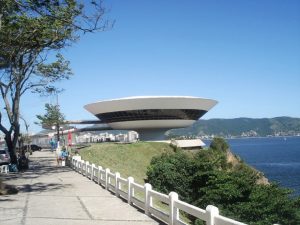The history of the Gateway Arch, St Louis, also known as the St Louis Arch, designed by Eero Saarinen and completed in 1965

The completed St Louis Arch standing in the unfinished Arch Grounds in the 1960’s
Picture taken from the air on December 10th 1967 by Reynold Ferguson
Eero Saarinen and the design of the Arch
The Gateway Arch, located at Memorial Drive, St Louis, Missouri was designed by the Finnish/American architect and industrial designer Eero Saarinen (born August 20th, 1910 in Kirkkonummi, Finland, died September 1st 1961, Ann Arbor, Michigan) and the American/German structural Engineer, Hannskarl Bandel (born May 3rd 1925 Dessau, Germany, died December 29th, 1993 Aspen, Colorado) the arch is also known as the St Louis Arch.

The Gateway Arch, St Louis, Missouri, USA
The Gateway arch is built in the form of a flattened catenary arch. A catenary arch simply being the shape formed by a chain or cable suspended between two fixed points. The diagram below actually show a catenary curve.

Diagram to show Catenary Arch by Larry Phillips of mathThoughts
The cost and construction for the project
The project had been discussed on and off since the 1930’s, mainly as a way of starting new jobs during the economic disaster that was the great depression. 5000 new jobs was the predicted number in all the forecasts, in reality the project only created 100 new jobs in total.
The Gateway Arch, St Louis, under construction in 1965 showing triangular cross section

The Gateway Arch, St Louis, under construction in 1965 showing triangular cross section
Photo St Louis History Museum
Construction finally started in 1963 on February 12th and finished on October 28th 1965. The total cost in 1965 of the Gateway Arch was 13 million USD, which is around 93-94 million USD today. The Arch cost 11 million USD with 2 Million bidding allowed for the transport system inside the arch. MacDonald Construction Co. of St Louis was awarded the contract for construction as the lowest bidder.
There are, today, three ways of scaling the interior of the Arch, there are two sets of emergency stairs, one in each leg and consisting of 1076 steps per staircase. There is an elevator that can accommodate twelve passengers and there is also a tram in each leg of the arch.

Interior of the arch showing the Observation platform stop off the Gateway arch north tram. St. Louis, MO, USA
The Jefferson National Expansion Memorial Association, JNEMA
The non-profit making organisation Jefferson National Expansion Memorial Association JNEMA—pronounced “Jenny May” – was set up in 1933 with the following remit:-
“A suitable and permanent public memorial to the men who made possible the western territorial expansion of the United States, particularly President Jefferson, his aides Livingston and Monroe, the great explorers, Lewis and Clark, and the hardy hunters, trappers, frontiersmen and pioneers who contributed to the territorial expansion and development of these United States, and thereby to bring before the public of this and future generations the history of our development and induce familiarity with the patriotic accomplishments of these great builders of our country.”
Built as a monument to the westward expansion of the United States, the Gateway Arch is the centrepiece of the Jefferson National Expansion Memorial and has become the internationally famous iconic symbol of St. Louis.
Materials
The Gateway Arch is huge, just massive. It stands at 192 meters high, which makes it both the tallest arch ever built and the tallest monument built by the United States of America. The arch’s width is the same 192 meters as its span. The Gateway Arch is the largest stainless steel building in the world.
The Gateway Arch is fabricated from 6.3mm thick grade 304 stainless steel, which shows just how durable 304 can be. People often only specify 316 for outdoor projects thinking 304 unsuitable. The stainless steel is finished in No. 3 Finish – this finish is obtained with a ground unidirectional 80 to 100–grit abrasive. It is sometimes an intermediate step for finer finishes.
The stainless steel covering the arch weighs 804 tons, which is also the largest amount of stainless steel used in a single project.

Photograph from below the St Louis Arch.
Thoughts of the experts
Peter Kaster — History Professor, Washington University in St. Louis
“The Gate Way arch was pretty well received at the time of construction. People actually had the ‘Go West, young man’ mentality and the Arch encouraged this movement”
William Gass — Author, Philosopher
“A lot of the people who did this had never had much of a chance before.”
Robert Duffy — Architecture Critic, St. Louis Post Dispatch
“You see in their faces a sense of hard work but also a certain sense of victory. They have accomplished something, they have moved on, they’ve gone someplace that no one has ever been before.”










